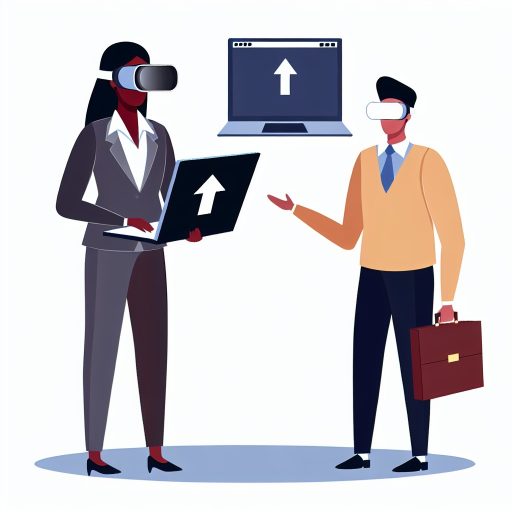Introduction to Virtual Reality in Real Estate Staging
Virtual reality (VR) transforms the way buyers experience real estate.
This technology creates immersive environments for potential homeowners.
With VR, clients can visualize spaces without physical presence.
Additionally, it enhances property staging and design processes.
The Rise of Virtual Reality in Real Estate
Over the past few years, VR technology has evolved significantly.
Many real estate professionals now utilize this innovative tool.
By incorporating VR, agents can attract more buyers effectively.
Moreover, they provide an engaging way to showcase properties.
Benefits of Using Virtual Reality
VR offers numerous advantages for real estate staging and design.
- First, it saves time for both agents and clients.
- Secondly, buyers can explore multiple properties quickly.
- Lastly, VR allows for enhanced design customization.
How Virtual Reality Works in Real Estate
VR employs headsets and software to create realistic experiences.
Users can walk through a virtual property from any location.
This technology allows for interactive elements within the space.
For instance, clients can change colors and furniture arrangements.
Challenges and Considerations for Virtual Reality
Despite its benefits, implementing VR has challenges.
Some buyers may experience discomfort or motion sickness.
Transform Your Real Estate Decisions
Unlock personalized real estate insights crafted just for you. Get actionable advice designed to amplify your success.
Get StartedAdditionally, creating high-quality virtual tours can be costly.
As a result, agents must weigh the pros and cons carefully.
Benefits of Using Virtual Reality for Home Staging
Enhanced Visualization
Virtual reality allows potential buyers to visualize a home instantly.
This technology creates immersive experiences that traditional photos cannot provide.
As a result, buyers can feel as if they are walking through the property.
This deep immersion helps them connect emotionally with the space.
Increased Engagement
Engagement levels soar when clients experience homes in virtual reality.
The interactive elements stimulate interest and curiosity.
Consequently, clients stay engaged for longer periods during showings.
Moreover, VR allows them to explore homes at their own pace.
Cost Efficiency
Using VR for staging can significantly reduce costs for sellers.
Virtual staging eliminates the need for physical furniture and decor.
Additionally, it minimizes the time required for traditional staging efforts.
This efficiency can save real estate agents and sellers money in the long run.
Showcase Your Real Estate Business
Publish your company profile on our blog for just $200. Gain instant exposure and connect with a dedicated audience of real estate professionals and enthusiasts.
Publish Your ProfileRemote Accessibility
Virtual reality makes properties accessible to remote buyers.
Clients can tour homes from anywhere in the world using VR headsets.
This feature widens the market for sellers, increasing potential offers.
Consequently, it enhances opportunities for successful transactions.
Customization Options
VR allows buyers to customize their space during virtual tours.
They can experiment with different layouts and designs effortlessly.
This ability encourages clients to envision their own style in the home.
Moreover, it fosters a stronger connection to the property.
Quick Updates and Revisions
Virtual reality enables quick updates to home staging designs.
When changes are needed, they can be implemented easily.
This flexibility benefits both sellers and their agents considerably.
It ensures that the home staging is always fresh and appealing.
How Virtual Reality Transforms Property Design and Layout
Creating Immersive Experiences
Virtual reality revolutionizes how buyers explore properties.
This technology provides a 360-degree view of homes.
As a result, potential buyers feel more engaged.
They can interact with spaces from the comfort of their homes.
This immersion enhances their understanding of layouts.
Streamlining Design Processes
Designers utilize virtual reality to visualize projects rapidly.
They can modify designs in real time based on client feedback.
This leads to faster decision-making and reduced revisions.
Consequently, the entire design process becomes more efficient.
Enhancing Marketing Strategies
Property listings benefit greatly from virtual reality content.
Agencies can create virtual tours to attract prospective buyers.
This strategy showcases properties effectively and creatively.
Moreover, it sets listings apart in competitive markets.
Cost-Efficiency and Time Savings
Virtual reality reduces costs associated with traditional staging.
Buyers can view multiple designs without physical changes.
This not only saves money but also reduces time spent on showings.
In addition, clients can explore various styles before making decisions.
Encouraging Customization
VR technologies empower clients to customize spaces.
Showcase Your Real Estate Business
Publish your company profile on our blog for just $200. Gain instant exposure and connect with a dedicated audience of real estate professionals and enthusiasts.
Publish Your ProfileThey can experiment with different layouts and color palettes.
This capability fosters a sense of ownership and creativity.
As a result, clients are more satisfied with their final choices.
Find Out More: Real Estate Mobile Apps for Finding Foreclosures and Bank-Owned Homes
Comparing Traditional Staging vs. Virtual Reality Staging
Overview of Traditional Staging
Traditional staging involves physically arranging furniture and decor in a home.
This method shows the space’s potential to prospective buyers.
Stagers enhance rooms using existing items or rented pieces.
They also often paint, remodel, or make other changes to improve visuals.
Benefits of Traditional Staging
One primary benefit is the immediate emotional impact on buyers.
People can physically experience the space during walk-throughs.
Additionally, traditional staging allows for a customized touch.
Stagers can tailor designs to match current market trends.
Limitations of Traditional Staging
Traditional staging can be time-consuming and costly.
Traveling to various locations for setup adds to the overall expense.
Moreover, physical staging can only showcase a single design at a time.
This limits creativity and flexibility in showcasing multiple styles.
Overview of Virtual Reality Staging
Virtual reality staging allows potential buyers to explore spaces digitally.
With VR technology, users can take virtual tours from anywhere.
This method enables buyers to see various design styles in real-time.
Designs can be altered quickly and effectively within a digital platform.
Benefits of Virtual Reality Staging
One significant benefit is the cost-effectiveness of VR staging.
It eliminates the need for physical furniture or decor rentals.
Furthermore, VR staging speeds up the home-selling process.
Buyers can visualize their future home without physical presence.
Limitations of Virtual Reality Staging
Some potential buyers may prefer an in-person experience over VR.
VR technology requires suitable equipment, which can be a barrier.
Additionally, users may need training to navigate virtual platforms.
Realism in virtual designs can vary significantly based on software used.
Advantages of Combining Traditional and Virtual Reality Staging
Combining traditional and virtual reality staging can be advantageous.
Each method offers unique strengths that enhance the home-selling experience.
Showcase Your Real Estate Business
Publish your company profile on our blog for just $200. Gain instant exposure and connect with a dedicated audience of real estate professionals and enthusiasts.
Publish Your ProfileUsing both allows for broader audience engagement.
Buyers receive a more comprehensive view of properties through diverse means.
Find Out More: IoT Sensors for Smart Property Inspections
Technology Behind Virtual Reality in Real Estate
Overview of Virtual Reality
Virtual reality immerses users in a 3D environment.
This technology simulates physical presence in a virtual world.
Users can interact with this environment in real-time.
Key Technologies Used
Several technologies drive virtual reality in real estate.
Head-mounted displays offer an immersive viewing experience.
They provide high-resolution visuals for detailed imagery.
Motion tracking sensors enhance user interactions.
These sensors detect movement and adjust the view accordingly.
Additionally, spatial audio technology adds depth to immersion.
Software Applications
Various software platforms support virtual reality in real estate.
These applications create realistic 3D models of properties.
They allow agents to showcase homes effectively.
Furthermore, staging software customizes interior designs.
This software enables clients to envision potential spaces.
Benefits of VR Technology
Virtual reality offers numerous advantages for real estate.
It enhances property marketing strategies significantly.
With VR, clients can tour properties from anywhere.
This accessibility increases interest and engagement.
Moreover, it reduces the time spent on physical showings.
Agents can focus more on clients’ needs and concerns.
Emerging Trends Shaping Virtual Reality in Real Estate
The future of virtual reality in real estate looks promising.
Advancements in technology will further enhance realism.
Integration with artificial intelligence will personalize experiences.
Furthermore, expanded use of VR will revolutionize property views.
As technology evolves, client expectations and experiences will improve.
Explore Further: Google Ads for Real Estate Agents to Generate High-Intent Buyer Leads

Case Studies: Successful Implementations of VR in Real Estate
Transforming Sales Strategies
In 2021, Horizon Realty implemented VR technology to showcase their listings.
Showcase Your Real Estate Business
Publish your company profile on our blog for just $200. Gain instant exposure and connect with a dedicated audience of real estate professionals and enthusiasts.
Publish Your ProfileThis innovative strategy increased their property viewing rate by 45%.
Clients appreciated the immersive experience from any location.
As a result, Horizon Realty closed 30% more deals than the previous year.
Enhancing Buyer Engagement
Summit Properties incorporated VR tours into their marketing efforts.
These tours allowed potential buyers to explore homes remotely.
The method helped clients visualize their future homes more easily.
Consequently, Summit Properties saw a 50% increase in client engagement.
Streamlining Home Design
Innovate Interiors utilized VR for their interior design projects.
Clients could experience designs before making final decisions.
This approach reduced revisions and enhanced client satisfaction.
The company reported a 70% decrease in design-related errors.
Creating Virtual Open Houses
Elite Living Group hosted virtual open houses using VR technology.
The events attracted more potential buyers than traditional methods.
They created a realistic open house experience for remote clients.
As a result, Elite Living noted a marked increase in leads.
Innovative Staging Solutions
Virtual Staging Solutions offered virtual staging services to their clients.
This service allowed homeowners to visualize spaces fully furnished.
The company reported quicker sales due to appealing virtual images.
Virtual Staging Solutions achieved a 40% increase in client referrals.
You Might Also Like: AI-Powered Real Estate Valuation and Property Pricing
Future Trends: Where VR in Real Estate is Heading
Increased Adoption of VR Technology
Real estate professionals increasingly embrace virtual reality technology.
This shift enhances property marketing and client engagement.
More agents will use VR tours as standard practice.
Homebuyers enjoy immersive experiences from the comfort of their homes.
Integration with Augmented Reality
Augmented reality is set to complement virtual reality in real estate.
Potential buyers will visualize properties with added digital elements.
This technology will enhance the overall staging process.
Users can overlay furniture and decor while viewing properties.
Advancements in VR Software
New software developments will improve VR experiences in real estate.
High-quality graphics and user-friendly interfaces will become the norm.
Showcase Your Real Estate Business
Publish your company profile on our blog for just $200. Gain instant exposure and connect with a dedicated audience of real estate professionals and enthusiasts.
Publish Your ProfileAdditionally, customizable features will cater to individual client preferences.
These advancements will elevate the professionalism of virtual tours.
Wider Accessibility of VR Devices
The affordability of VR devices is increasing rapidly.
More clients will have access to VR headsets and apps.
This accessibility will encourage a broader audience to engage with VR content.
Consequently, real estate firms will reach more potential buyers.
The Role of AI and Machine Learning
Artificial intelligence will enhance virtual reality applications in real estate.
AI can analyze client preferences and suggest personalized property options.
This technology will streamline the buying process significantly.
Furthermore, machine learning will adapt marketing strategies based on user behavior.
Environmental Considerations
Sustainable building practices will merge with virtual reality design.
Clients will visualize eco-friendly designs through VR simulations.
This focus will help promote green living and energy efficiency.
As a result, buyers will appreciate properties aligned with their values.
Challenges and Limitations of Virtual Reality in Staging
High Costs of Implementation
Virtual reality technology can be expensive to acquire.
It can also be costly to implement.
Many real estate businesses may find initial costs prohibitive.
Ongoing maintenance can add to these expenses.
Technical Limitations
Not all properties are suited for virtual reality staging.
Some homes have unique architectural features.
These features may not be easily replicated in virtual environments.
User Experience Challenges
Not all clients are comfortable using VR technology.
Some potential buyers may find VR experiences disorienting.
This discomfort can hinder their ability to visualize spaces effectively.
Limited Realism
While VR offers immersive experiences, it can lack realism.
Some virtual representations may not match actual properties.
This discrepancy can lead to disappointment during physical showings.
Dependency on Technology
VR staging relies heavily on technology to function effectively.
Issues such as software glitches or hardware failures can disrupt presentations.
This reliance may deter some real estate professionals from adopting VR solutions.
Showcase Your Real Estate Business
Publish your company profile on our blog for just $200. Gain instant exposure and connect with a dedicated audience of real estate professionals and enthusiasts.
Publish Your ProfileMarket Adaptation
Virtual reality is still new in the real estate industry.
Not all agents are prepared to embrace this technology.
As a result, the market may require time to adapt fully.




